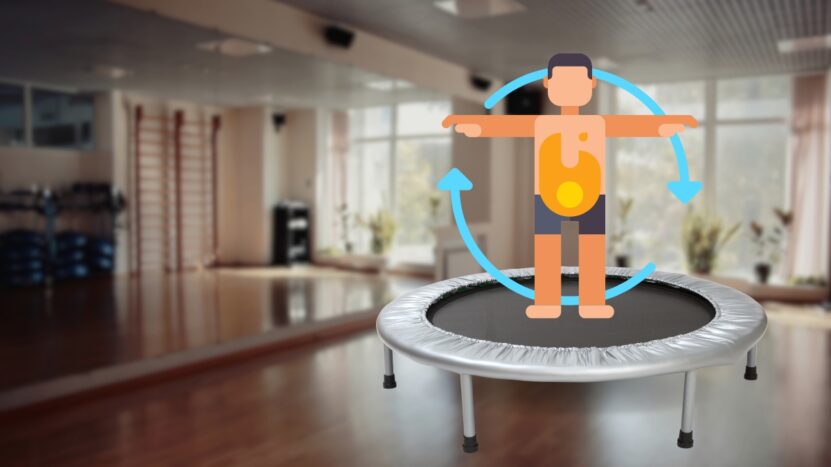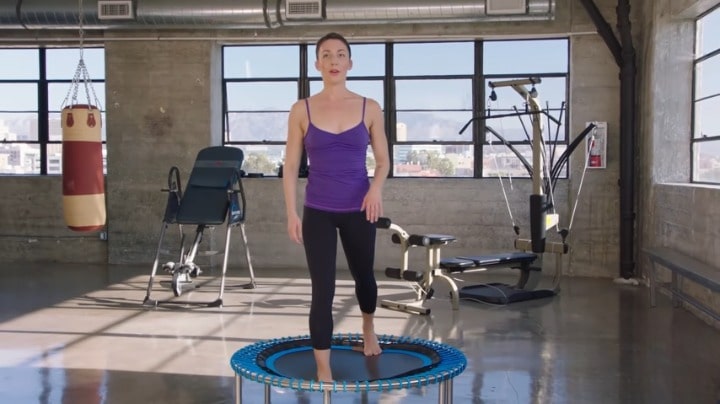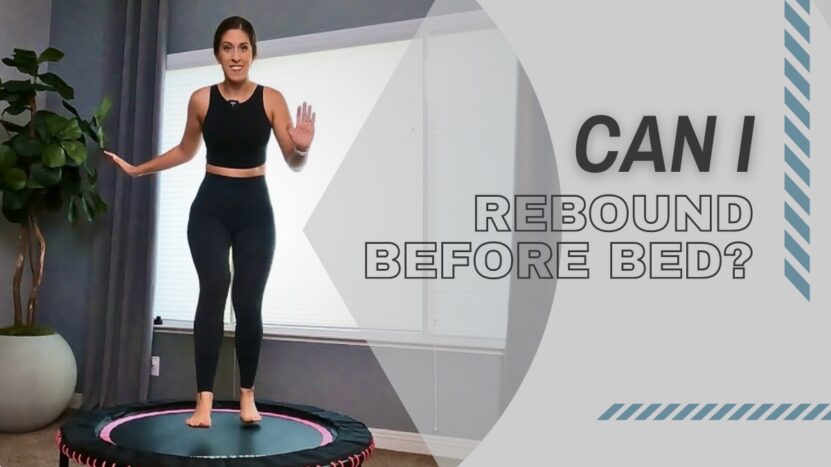While rebounding has many health benefits, some people are concerned that it may interfere with their sleep if done too close to bedtime. In this article, we will explore the effects of rebounding on sleep and provide recommendations for when and how to rebound to maximize its benefits without disrupting your sleep. Whether you’re new to rebounding or a seasoned pro, understanding the best practices for timing your workouts can help you get the most out of your exercise routine while maintaining healthy sleep habits.
Understanding the Concept of Rebounding

Rebounding, the act of jumping on a mini-trampoline, is a low-impact exercise that provides various health benefits. This activity helps to burn calories and improve lymphatic circulation in the body. It can provide an additional benefit of relaxation and help to improve sleep quality. It is essential to ensure appropriate time gaps between rebounding and sleeping to avoid any adverse effects on the body’s internal clock.
Moreover, incorporating it into your daily routine can boost stamina and balance while reducing stress levels. As a result, individuals with joint problems or injuries may find this activity particularly beneficial. Even though it seems enjoyable, it is imperative to maintain proper safety measures while performing this exercise.
Benefits of Rebounding Before Bed
To reap the benefits of rebounding before bed, learn about the advantages it provides to your body. Improved sleep quality, Increased metabolism, and Reduced stress and anxiety are the sub-sections that will be discussed. Discover the positive impacts of this activity, including better sleep, increased calorie burning, and relief from stress and anxiety.
Improved sleep quality
Rebounding exercise before bed enhances the overall sleep quality, allowing you to wake up feeling refreshed. The rhythmic bouncing motion contributes to a peaceful and relaxed mental state, which makes it easier to fall asleep. Moreover, rebounding improves blood circulation and lymphatic flow, leading to better tissue regeneration during sleep. This process repairs any muscle damage or injuries that may have occurred during the day.
A lesser-known benefit of rebounding before bed is its ability to reduce stress levels. By releasing endorphins and reducing cortisol production, rebounding can have a calming effect on the mind and body.
Increased metabolism

Regular rebounding before bedtime can boost your body’s metabolic rate. This form of exercise involves jumping on a trampoline, which results in increased heart rate and circulation, aiding the body in burning more calories even at rest. This process is called post-exercise oxygen consumption (EPOC) and can last for up to 48 hours after a workout. This exercise not only increases metabolism but also helps regulate blood sugar levels by improving insulin sensitivity.
The movement involved in rebounding stimulates the lymphatic system, resulting in improved detoxification and immune function. It can help increase the quality of sleep as well. Studies have found that exercise before bedtime improves both the duration and quality of sleep, leaving you feeling more energized and refreshed upon waking up.
According to Harvard Health Publishing, regular exercise such as rebounding has been linked to reducing the risk of chronic illnesses like heart disease and diabetes. Incorporating it into your bedtime routine can provide multiple benefits for your overall health. So if you’re looking for a fun and effective way to improve your well-being, consider adding rebounding to your daily routine. It can help you bounce away your stress and anxiety, but just make sure you don’t rebound straight into your ceiling fan.
Reduced stress and anxiety
Engaging in rebounding activity before bed can alleviate your mental health by reducing daily life stressors and anxiety. This is because it helps to discharge the energy stored throughout the day, promoting a sense of calmness and relaxation. The rhythmic movements involved in rebounding help release endorphins that positively affect your mood and attitude, enabling you to combat stressors with greater resilience.
Furthermore, it has been found to increase your quality of sleep. By releasing pent-up energy and improving blood circulation, it encourages better regulation of your internal body clock, leading to enhanced rejuvenation during sleep. This improved rest benefits your emotional well-being by providing necessary physical recovery for mental health support.
Incorporating this low-impact exercise as a pre-bedtime ritual ensures that you begin the next day fully refreshed while maintaining good mental health. Remember that taking care of yourself through exercise can be a vital aspect of a self-care routine that one should not miss out on.
Precautions to take before rebounding before bed
To ensure safety while doing this exercise, take proper precautions. Warm-up exercises, proper attire, and environment are vital for avoiding injury and getting the best benefits from your workout.
Warm-up exercises
To adequately prepare your body for a rebounding session, it’s essential to perform some preliminary exercises. Priming your muscles and joints before engaging in any physical activity is crucial—for this reason, the suggested term for this section becomes ‘Physical Preparation’ or ‘Athletic Conditioning’.
Incorporating these exercises into your routine helps reduce strain on your muscles and joints. Here are the six essential exercises that you must do as part of your Physical Preparation routine. These activities can help improve balance and coordination while helping prevent injuries:
- Jumping Jacks
- Squats
- Lunges
- High knees
- Ankle circles
- Arm swings.
These exercises are crucial in preparing for a successful trampolining experience. They help to condition the body to the increased physical demands that trampolining requires. Failing to warm up correctly can lead to disastrous results, as Nicolle Sullivan found out first-hand. She went straight into rebounding without warming up and ended up twisting her ankle after an awkward landing. Don’t risk getting injured; always remember to warm your body up before jumping on the trampoline.
Additionally, it’s worth noting that you should wear appropriate attire for a successful rebounding experience. Consider wearing comfortable and lightweight clothing, such as athletic shorts and a T-shirt. And remember, pajamas are not appropriate attire for trampolining!
Proper attire
To ensure safety while rebounding before bed, appropriate clothing is crucial. The attire should not restrict movement and must be breathable to avoid overheating. Wear proper athletic shoes with non-slip soles that grip the trampoline surface. Optionally, you can wear compression sleeves or knee braces for additional support. Rebounding in bare feet or sandals is highly discouraged as it may cause injury and reduce performance quality.
Additionally, avoid wearing any loose jewelry or accessories that may get tangled during the exercise routine, distract your focus, and interfere with your motion range, causing discomfort or accidents. It is noteworthy to mention that over-dressing can also have an adverse effect if the clothing layers become too heavy and make you sweat excessively, which will increase the risk of slipping off the trampoline’s surface.
Wearing proper attire during rebounding will help keep you safe and comfortable while exercising effectively. According to a fitness expert from Healthline.com, “Improper jumping form or falls can result in injuries like sprains, fractures or head trauma.” So let’s take the necessary precautions to avoid such accidents.
Environment
Creating a suitable atmosphere for rebounding is crucial before going to bed. Dimming the lights and choosing a quiet spot in your home can help create a relaxing environment for bouncing. Additionally, ensuring proper ventilation and avoiding distractions such as electronics can further enhance the ambiance. When it comes to the environment, it’s important to consider factors that affect your quality of sleep.
For instance, avoid rebounding in an area with bright lights or loud noises that can disrupt your rest. Instead, choose a space that promotes calmness and tranquility, like your bedroom or living room. Moreover, ensure that the temperature of your room is conducive to a comfortable sleeping experience. It raises body temperature, and thus feeling overheated during sleep can cause discomfort. Well-controlled temperatures will help you stay cool and get a restful sleep throughout the night.
In my experience, I rebounded in my living room right before bedtime without considering my surroundings. The environment was not calming, causing me to struggle to fall asleep for hours even though I was physically exhausted from exercising on my rebounder. Since then, I’ve learned how vital it is to take care of all environmental factors before indulging in any physical activity close to bedtime.
Guidelines for rebounding before bed
To get optimal results, adhere to the guidelines for rebounding before bed with attention to duration, intensity, and frequency. These aspects play a vital role in your body’s response to rebounding, and understanding them will help you maximize the benefits of this practice.
Duration
While it is recommended to do it for at least 15 minutes a day, the ideal duration for rebounding before bed may vary from person to person. However, doing it for 10 to 20 minutes before bedtime can promote relaxation and help in releasing any built-up tension in the body. It is important not to overdo it as a vigorous workout can have the opposite effect and cause restlessness instead.
Experiment with different durations to determine what works best for your body and schedule. To maximize the benefits, pair it with progressive muscle relaxation techniques or deep breathing exercises. This combination will create a calming effect on the mind and help fall asleep effortlessly. Don’t miss out on the regenerative power of quality sleep that comes from a relaxed state of mind and body. Start incorporating rebounding into your bedtime routine today.
Intensity

The level of exertion during rebounding before bed should be moderated to ensure comfortable relaxation and quality sleep. Therefore, the intensity must be adjusted to a low or moderate level based on individual comfort and energy levels. Avoid high-intensity workouts that can cause stiffness or soreness and disrupt sleep. To maintain the appropriate intensity for rebounding before bed, start with a slow warm-up routine, gradually increasing the tempo.
Focus on movements that promote relaxation and flexibility and avoid excessive jumping or bouncing movements. If you experience fatigue or discomfort during the exercise, reduce the intensity levels further to ensure maximum relaxation before sleep. It’s important to note that adjusting intensity levels is necessary even if you have experience in rebounding exercises. The body’s energy levels fluctuate throughout the day, so it’s best to assess your current energy status before exercising to make any adjustments needed.
Frequency
Maintaining a consistent rebounding practice can be practiced regularly for maximum benefits. A recommended frequency would be to rebound daily for at least 10 minutes, with some days dedicated to longer sessions. Deliberate and consistent effort will enhance sleep quality, lymphatic function, and blood circulation, and boost energy levels. Practice effective rebounding techniques It is important to adhere to correct techniques coupled with controlled and intentional movements.
One way of doing this is by starting slow and low, increasing the intensity gradually while maintaining proper alignment of the body throughout the exercise. The use of quality rebounders such as Bellicon or Cellerciser can also help prevent strain on joints. Give Yourself Time As with any exercise routine, it is important to note that visible results may not be immediate but with continued practice, health benefits are inevitable.
Alongside regular rebounding sessions before bedtime try incorporating wholesome diet options to further enhance immunity levels holistically. Don’t miss out on better sleep incorporating a consistent workout schedule before bed has multiple tangible health benefits and improves overall well-being. With easily attainable resources such as a mini-trampoline readily available in stores or online shops, there’s no excuse to miss out on gaining better sleep habits accompanied by mindfulness practices. Start today!
FAQs

What type of trampoline is best for rebounding before bed?
A mini-trampoline, also known as a rebounder, is the best type of trampoline for rebounding before bed as it is low-impact and easy on the joints.
How often should I rebound before bed?
The frequency of your rebounding sessions before bed depends on your fitness level and goals. Aim to rebound at least 2-3 times a week.
Can rebounding before bed help with anxiety and depression?
Rebounding before bed can help reduce stress, anxiety, and symptoms of depression by promoting relaxation and releasing endorphins.
Is it safe to rebound before bed if I have a pre-existing medical condition?
If you have a pre-existing medical condition, it is important to consult with your doctor before rebounding before bed to ensure it is safe for you.
How can I incorporate rebounding before bed into my workout routine?
To incorporate rebounding before bed into your workout routine, try starting with shorter sessions and gradually increasing the time. Listen to your body and adjust your routine as needed to avoid overexertion or injury.
Conclusion
It’s important to keep in mind that the timing and intensity of rebounding vary from person to person. While some might find evening workouts beneficial for their sleep patterns, others may encounter difficulty falling asleep after energizing sessions. Factors like age, fitness levels, and medical history play a fundamental role in deciding whether rebounding at night suits an individual.
Instead of focusing on the time of day, consider listening to your body and adhering to physical activity guidelines while choosing when and how much to rebound. Incorporate healthy habits such as maintaining suitable food habits during the day or following relaxation techniques like yoga for winding down before sleep.
Incorporating regular rebounding workouts can boost overall physical health; however, its effectiveness depends on approaches tailored to one’s health status and availability. It makes sense not to underestimate personal experience while considering variables such as age group or lifestyle factors that impact how our bodies react to different kinds of exercise routines.

